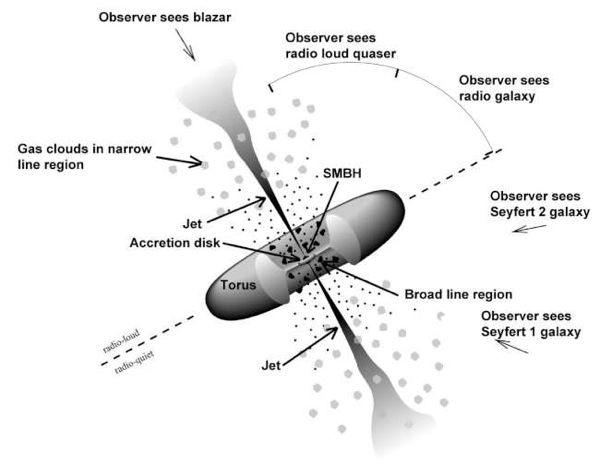Active Galactic Nuclei (AGN)
Active galactic nuclei (AGN) are highly energetic astrophysical objects that are powered by actively accreting supermassive black holes (SMBH; MBH ≥ 106MSun) at their centres, and produce unique observational features over the entire electromagnetic (EM) spectrum (Rees 1984). About 15% of AGN consist of two well-collimated jets of ultrarelativistic particles extending to kilo-parsec (kpc) or sometimes up to mega-parsec (Mpc) distances and are known as jetted-AGN (Padovani et al. 2017). The spectra of these jetted-AGN strongly depend on the viewing angles of their jets with respect to the observer’s line of sight and this difference forms the base for their classification. Blazars are the jetted-AGN aligned at very small (≤ 15-20◦) viewing angles (Urry & Padovani 1995). Their spectra are fully dominated by non-thermal radiation from the relativistic jets. Blazars are usually subdivided into flat-spectrum radio quasars (FSRQs) and BL Lac objects (BLLs) (e.g., Stocke et al. 1991; Marcha et al. 1996). It has been suggested that the division between these two subclasses could be due to their different accretion regimes with FSRQs having higher accretion rates above 10-2 of the Eddington rate (Ghisellini et al. 2009).

References
- Ghisellini, G., Maraschi, L., & Tavecchio, F. 2009, MNRAS, 396, L105
- Marcha, M. J. M., Browne, I. W. A., Impey, C. D., & Smith, P. S. 1996, MNRAS, 281, 425
- Padovani, P., Alexander, D. M., Assef, R. J., et al. 2017, A&ARv, 25, 2
- Rees, M. J. 1984, ARA&A, 22, 471
- Stocke, J. T., Morris, S. L., Gioia, I. M., et al. 1991, ApJS, 76, 813
- Urry, C. M., & Padovani, P. 1995, PASP, 107, 803